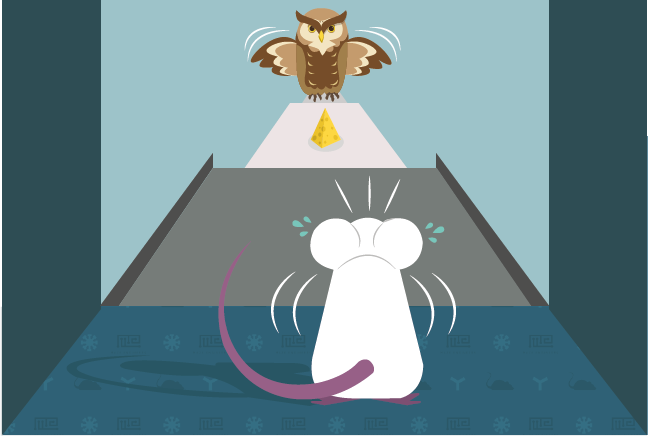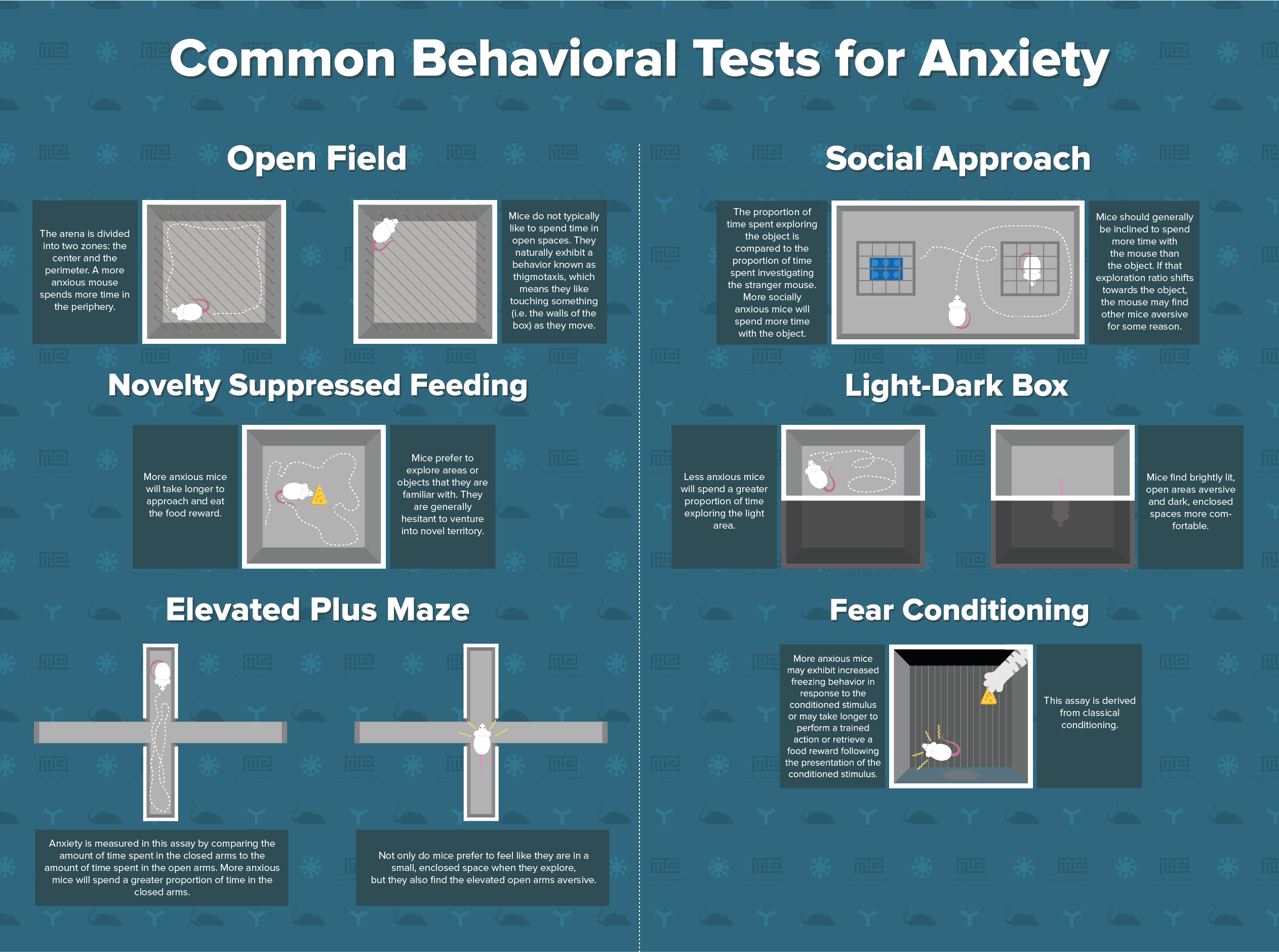We routinely count on animal models to understand complex human emotions and experiences, many of which cannot reasonably be expected to fully recapitulate in an animal. Often, there is some sort of manipulation in the model, or many training sessions are required to evoke the desired behavior. Fortunately, however, there are some innate behaviors that humans and animals share to some extent. Anxiety is one such human emotion that has a relatively robust analog in many other animals. While a mouse may not worry about paying his rent or acing that final exam he has coming up, he will naturally be wary of wide open spaces where a bird could snatch him up at any moment. Therefore, animal models of anxiety is very important for us to be able to investigate the natural behaviors resulting from rodent anxiety.

Important Considerations for Animal Models of Anxiety
In animal models of anxiety, it is important to test the innate behaviors of the animals to better understand them. When testing an untrained behavior, there will often be a limited number of trials available to gather data (sometimes only one). This is because the behavior of interest is meant to be natural, uninfluenced by previous experience. Every exposure to the paradigm will familiarize the animal with the experimental setup. As the animal becomes more familiarized, the resulting behavior loses inherent validity. Thus, it is important to work deliberately and plan ahead so the necessary data is easily accessible from the beginning.
While testing mice in animal models of anxiety, it must be noted that mice are “prey” animals. They are afraid of everything, especially that big scary human that just reached into their cage for the first time and tried to pick them up by the tail. Before any anxiety testing of any kind, it is imperative that the mice have been adequately habituated to any potentially anxiety-inducing stimulus that is irrelevant to the test itself. Physically handling the mice is a great place to start. When unaccustomed to behavioral assessments, mice tend to be incredibly skittish, darting away from hands that enter their cage, running or jumping off after being set down. This heightened state of anxiety isn’t good for the mouse, or behavioral data in animal models of anxiety
When planning anxiety tests, factor in a “habituation” period, slowly introducing the mice to new stimuli that they’ll need to be comfortable with in order to be tested appropriately. For example, the week before testing, schedule five minutes per day to just hold the mice. Think about what you’ll be doing on the day of the test. Will the mice need to be scruffed? Let them get used to the feeling of being restrained. Will there be injections? Try giving them a saline injection in the days leading up to the test. Take some time to think about the environment they’ll be tested in as well.
Will they need to be moved from their colony room to a testing room? Will the testing room ring with noisy machines they’ve never heard before? Take them over to the testing room and let them sit there for an hour or so before testing day. On the actual testing day for any assay, about one hour habituation inside the testing room is recommended, regardless of introductory efforts.
Don’t save this for the day before testing! Introduce a few new things each day leading up to the test. As the mice get more comfortable, the resulting data becomes more reliable by eliminating potential confounds. It is also good “habituation” for experimenters; the more comfortable they are with procedures on testing day, the less likely it is to make mistakes which may cause unreliable data or stress – from the mice, and the scientist!
| Assay | Setup | Measure(s) of Anxiety | Rationale | Notes |
| Open Field | An open square arena, generally equipped with infrared beams to track movement. | The arena is divided into two zones: the center and the perimeter. A more anxious mouse spends more time in the periphery. | Mice do not typically like to spend time in open spaces. They naturally exhibit a behavior known as thigmotaxis, which means they like touching something (i.e. the walls of the box) as they move. | You can gather all sorts of data while the mouse is in the box. Open field yields other measurements such as the total distance traveled or number of rearing events, which can be used to assess qualities like gross locomotor phenotypes or hyperactivity. |
| Novelty Suppressed Feeding | Mice should be food-restricted and then placed in a well-lit, novel environment (e.g. an open field box) with a food reward in the center. | More anxious mice will take longer to approach and eat the food reward. | Mice prefer to explore areas or objects that they are familiar with. They are generally hesitant to venture into novel territory. | Avoidance behaviors (in this case latency to feed) can be enhanced by increasing the brightness of the arena or adding another aversive stimulus (e.g. odor from a predator). |
| Elevated Plus Maze | Mice are placed on a narrow, plus-shaped platform. Two opposing arms of the maze have walls on the sides; the other two arms have no barrier. | Anxiety is measured in this assay by comparing the amount of time spent in the closed arms to the amount of time spent in the open arms. More anxious mice will spend a greater proportion of time in the closed arms. | Not only do mice prefer to feel like they are in a small, enclosed space when they explore, but they also find the elevated open arms aversive. | Time spent in the square intersection of the arms is not counted in the total time spent exploring the maze when calculating proportions of time in each arm. |
| Social Approach | Mice are placed in an empty arena with two small cages (about the size of a cup). Under one cage is a novel object (e.g. a lego) and under the other is an unfamiliar mouse. | The proportion of time spent exploring the object is compared to the proportion of time spent investigating the stranger mouse. More socially anxious mice will spend more time with the object. | Mice should generally be inclined to spend more time with the mouse than the object. If that exploration ratio shifts towards the object, the mouse may find other mice aversive for some reason. | After the social approach test, the object can be swapped out for another stranger mouse to test social recognition. In this phase, mice normally spend more time with the new mouse. |
| Light-Dark Box | Mice are placed inside an arena with an enclosed dark area and a well-lit, open area. | Less anxious mice will spend a greater proportion of time exploring the light area. | Mice find brightly lit open areas aversive, and dark enclosed spaces more comfortable. | Mice are sensitive to the intensity of the light used in any test. Choosing the proper lighting level is important. |
| Fear Conditioning | Mice are conditioned to associate an aversive stimulus with a neutral stimulus. This can be achieved using several different paradigms. | More anxious mice may exhibit increased freezing behavior in response to the conditioned stimulus or may take longer to perform a trained action or retrieve a food reward following the presentation of the conditioned stimulus. | This assay is derived from classical conditioning. | Fear conditioning is commonly used to study cognitive functions such as learning and memory. |
Common Behavioral Tests for Anxiety
One of the nice things about working with a naturally skittish animal is the lot of ways in which their anxiety can be tested. Here’s a brief summary of some of the most common behavioral assays used in animal models of anxiety (using mice as the subject):

Natural Anxiety vs Pathological in Animal Models of Anxiety
“At best, pre-clinical experiments mostly resemble what a normal mammal would do when placed in a situation of threat and this may only, at best, reflect a blunted version of what a mammal with anxiety would express” (Andrews et al., 2014)[1]. In other words, much research in animal models of anxiety utilizes wild type animals and induces anxiety during the test, rather than utilizing an animal that demonstrates a pathological phenotype and subsequently assessing the effects of that pathology on the natural behavior. In animal models of anxiety this is an important distinction, because it limits the ability to draw conclusions about the pathology of anxiety disorders from tests of innate anxiety. Until this discrepancy is adequately addressed, there remains a significant obstacle in the pursuit of effective anxiolytics.
For information on the treatment for depression, you can read this article about anxiety, depression and the Rhodiola plant.
References
- Andrews, N.A., Papakosta, M., and Barnes, N.M. (2014). Discovery of novel anxiolytic agents – the trials and tribulations of pre-clinical models of anxiety. Neurobiology of Disease 61: 72-78.
